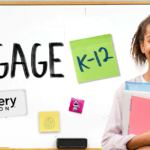Manchester City Schools found an unexpected strength in its station rotation model when school closures forced learning to move online.
By Cari Pugh
When we adopted a center rotation station model for some of our classrooms, we were trying to solve some age-old teaching challenges with limited resources. What we didn’t know was that the same qualities that make for good center rotation stations would also help us navigate the uncertainty of distance learning as schools shut down in response to COVID-19.
Moving to a Center Rotation Station Model
Our district is small, with two elementary schools and a middle school serving approximately 1,500 students in a rural, socioeconomically challenged area, so resources can get pretty thin. We have co-teaching classrooms in which a general education teacher and an exceptional education teacher partner to teach a classroom of students with diverse abilities.
With the center rotation station model, we can closely match student learning levels with hands-on activities students are interested in. Often, they learn without even realizing they’re doing it.
We have recently been expanding this model to include more small group center rotation stations, particularly in our co-teaching classrooms, to take advantage of the engagement without too much immediate supervision.
The Ecosystem
When the pandemic hit, we were ill-prepared for distance learning. We just don’t have the same resources and options as many larger districts, and many of our students’ families lack internet access or even devices to connect to it.
Fortunately, our technology department was able to step in and update some district-owned iPads for students to use at home to attend classes or work on schoolwork. Our families were already familiar with the Remind app, which we used to keep in touch with them. Seesaw was also already familiar to our families so, along with Google Classroom, it was a great channel for sharing assignments and activities or sending notifications about paper packet pickups.
From Center Rotation Stations to Distance
One bright spot in a trying time was the way some of our center rotation station resources made life easier for teachers and parents, while providing some stability in student routines.
We realized a bit before the pandemic that Square Panda literacy system, a multisensory literacy platform that we had in our center rotation stations, offered a way to track student data. Fortunately for us, the company was kind enough to send us several home units for free.
The ability for our teachers to monitor student progress and gain some insight into where students needed some extra support from a distance was a big advantage. The fact that it came through a tool our students already knew and enjoyed added some consistency and stability when those were hard to come by. Even our parents appreciated it because Square Panda was something their children could work on independently without adult supervision.
For hands-on STEM learning, we also adapted a couple center activities. In one, we give students plastic cups and ask them to arrange and stack them to make the most stable structure they can. Then we gave them additional materials, such as cardboard, index cards, and pipe cleaners, and encouraged them to experiment. For home use, we sent cups home with them, then asked them to get creative finding their experimentation materials from around the house and then share the results with classmates.
In a similar activity, we asked students to both flexible and rigid straws to create letters, numbers and shapes. At home, we ramped the challenge up a bit by asking them replicate designs using specified numbers of each kind of straw.
Other activities that transitioned well to distance learning and provided varying levels of hands-on interaction and independence included daily YouTube videos of teachers reading to students, letter scavenger hunts, “flat teacher” adventures, science activities, and the opportunity for students to share pictures of places they had visited or interesting things they had found.
Future Distance Connections
At Manchester City Schools, we’ve already reopened in-person for the 2020-2021 school year. I don’t think anyone knows if we’ll return to distance learning in the near future.
If we do have to transition to online learning, it will be difficult, but we’re much better prepared today. We’re developing plans for virtual instruction two months in advance so we won’t be caught by surprise if we close. And we feel confident that we can build on the experience we learned and the relationships we developed in the spring to keep our students engaged and progressing.
Cari Pugh is the supervisor of exceptional education at Manchester City Schools. She can be reached at cpugh@k12mcs.net.
The American Consortium for Equity in Education, publisher of the "Equity & Access" journal, celebrates and connects the educators, associations, community partners and industry leaders who are working to solve problems and create a more equitable environment for historically underserved pre K-12 students throughout the United States.
- American Consortium for Equity in Educationhttps://ace-ed.org/author/admin/
- American Consortium for Equity in Educationhttps://ace-ed.org/author/admin/April 23, 2025
- American Consortium for Equity in Educationhttps://ace-ed.org/author/admin/
- American Consortium for Equity in Educationhttps://ace-ed.org/author/admin/







